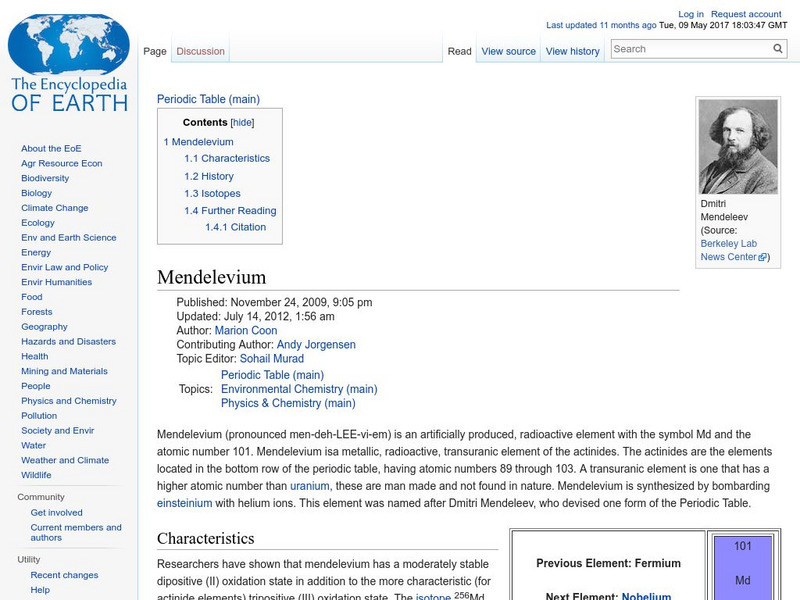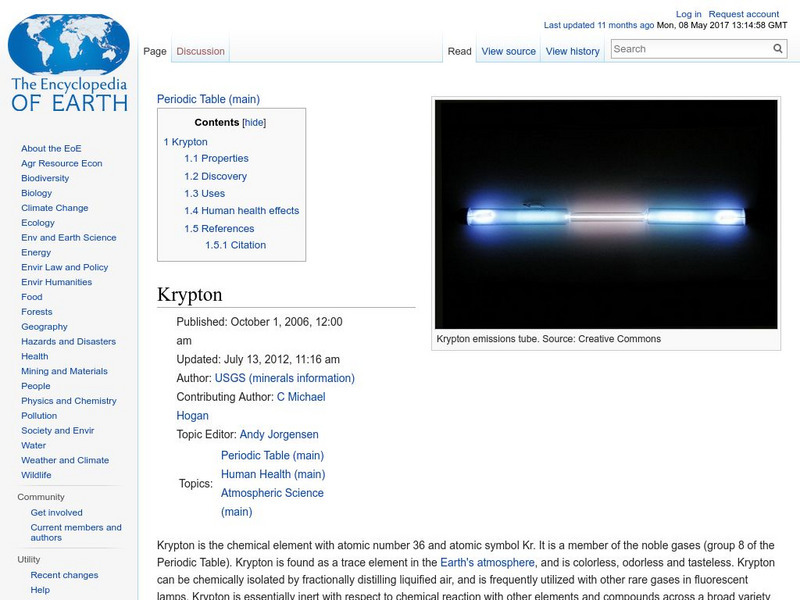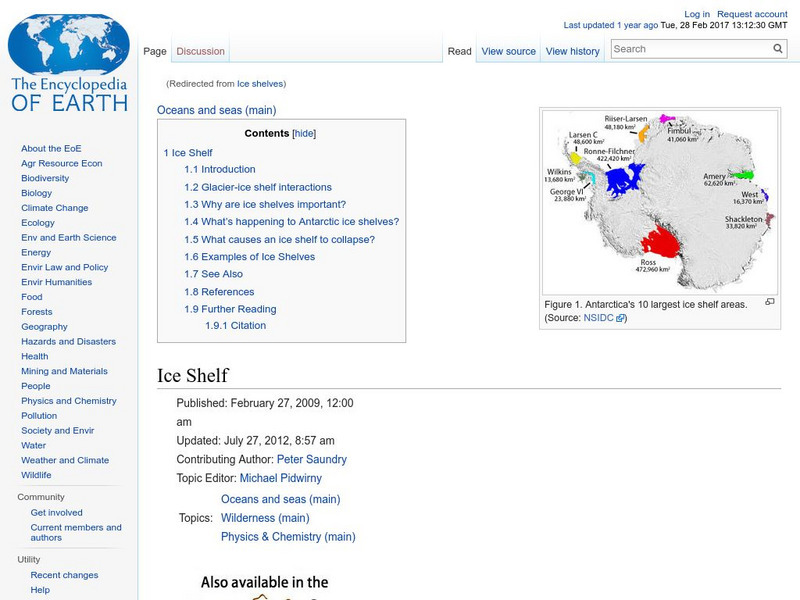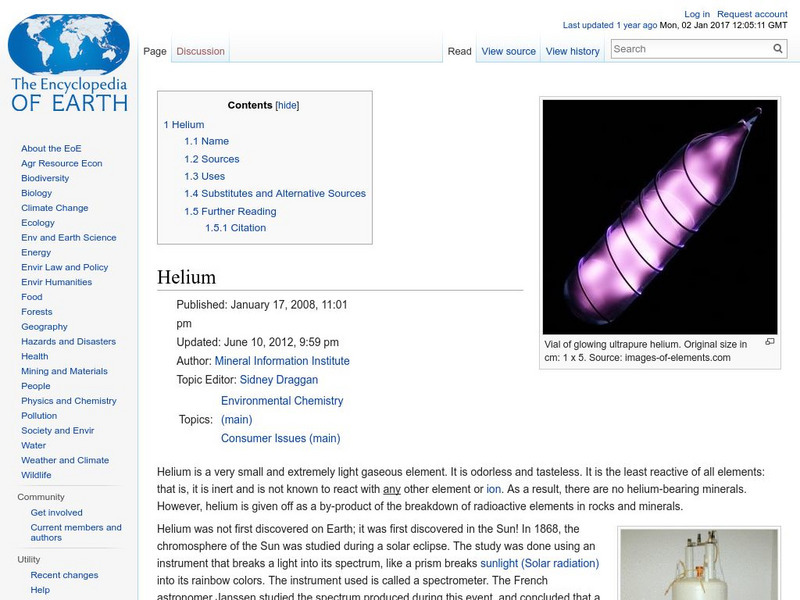Encyclopedia of Earth
Encyclopedia of Earth: Mendelevium
Information about the synthetic, radioactive element, Mendelevium, atomic number 101. Covers its discovery, physical and atomic properties, and details about permissible exposure.
Encyclopedia of Earth
Encyclopedia of Earth: Physics & Chemistry: Mass
Defines inertial and gravitational mass, their scientific history, formulas used in their calculation, the definition of weight, units used for mass, and mass as perceived in the theory of special relativity.
Encyclopedia of Earth
Encyclopedia of Earth: Botany: Mangrove Ecology
Extensive article on mangroves. Covers classification, physical characteristics, life cycle, habitat, economic value, and natural and human threats to their survival.
Encyclopedia of Earth
Encyclopedia of Earth: Curie, Marie Sklodowska
A biography of the scientist Marie Curie (1867-1934). With links to additional information.
Encyclopedia of Earth
Encyclopedia of Earth: Manganese
Information about the element, Manganese, atomic number 25. Covers physical properties, atomic properties, how abundant it is on the Earth, details about health-related regulations, and its importance to human health. Also discusses...
Encyclopedia of Earth
Encyclopedia of Earth: Evolutionary Biology: Mammal
Article explaining the basic characteristics of mammals, their diet, reproduction, behavior, conservation concerns, taxonomy, and their evolution. (Published: September 23, 2010)
Encyclopedia of Earth
Encyclopedia of Earth: Lutetium
Information about the element, Lutetium, atomic number 71. Covers physical properties, atomic properties, how abundant it is on the Earth, and details about health-related regulations.
Encyclopedia of Earth
Encyclopedia of Earth: Conservation Biology: Long Finned Pilot Whale
Information about the long-finned pilot whale, a member of the dolphin family. Covers physical features, lifespan, reproduction, behavior, diet, distribution, habitat, its conservation status, and efforts being taken to protect it....
Encyclopedia of Earth
Encyclopedia of Earth: Lithium
Information about the metallic element, Lithium, atomic number 3. Covers its discovery, its physical and atomic properties, how abundant it is on the Earth, sources, uses, potential substitutes, and permissible exposure limits.
Encyclopedia of Earth
Encyclopedia of Earth: Natural Gas: Liquefied Natural Gas
Article discussing what liquefied natural gas is, the liquefaction process, its history, how it is transported and stored, and safety considerations. (Published: September 13, 2011)
Encyclopedia of Earth
Encyclopedia of Earth: Geology: Limestone
Article explaining what limestone is, how it is formed, where it occurs, the different types, and how it has been used throughout history. (Published: August 8, 2010)
Encyclopedia of Earth
Encyclopedia of Earth: Ecology: Lichen
Article describing the different categories of lichens, their physical features, how they reproduce, their evolution, and important benefits lichens provide to humans. (Published: July 19, 2010)
Encyclopedia of Earth
Encyclopedia of Earth: Lead in Paint, Dust, and Soil
Facts about the health hazards associated with lead, where it can be found, when it is the most hazardous, how to check family members and your home for lead, and issues with older homes and with renovating. Includes links to numerous...
Encyclopedia of Earth
Encyclopedia of Earth: Lead
Information about the heavy metal, Lead, atomic number 82. Gives some interesting historical details about lead's use in the past. Covers physical properties, atomic properties, how abundant it is on the Earth, and details about...
Encyclopedia of Earth
Encyclopedia of Earth: Entomology: Larva
Article on the types and function of larvae in the animal life cycle.
Encyclopedia of Earth
Encyclopedia of Earth: Periodic Table: Krypton
Information about the element, Krypton, atomic number 36. Covers physical and atomic properties, how abundant it is on the Earth, how it was discovered, uses, and health effects from exposure.
Encyclopedia of Earth
Encyclopedia of Earth: Iron
Information about the element, Iron, atomic number 26. Covers physical properties, atomic properties, how abundant it is on the Earth, and details about health-related regulations, and its importance to plant and to animal health. Also...
Encyclopedia of Earth
Encyclopedia of Earth: Iodine
Information about the element, Iodine, atomic number 53. Covers physical and atomic properties, how abundant it is on the Earth, permissible exposure limits, sources, uses, and potential substitutes.
Encyclopedia of Earth
Encyclopedia of Earth: Oceans and Seas: Ice Shelf
Article explaining what ice shelves are, some different types, how they interact with one other, why they are important, what causes an ice shelf to collapse, and some examples of ice shelves in the Arctic and Antarctic. (Published:...
Encyclopedia of Earth
Encyclopedia of Earth: Climate Change: Ice Cores and History of Climate Change
Article describing research done in the West Antarctica, where ice cores were removed to a depth of two miles, providing information on climate change over the last one hundred thousand years. (Date published: Feb. 2, 2011)
Encyclopedia of Earth
Encyclopedia of Earth: Hydrogen
Information about the first element on the periodic table, Hydrogen, atomic number 1. Covers its history, sources, physical and atomic properties, places it occurs naturally on the Earth and in space, its many uses, and forms in which it...
Encyclopedia of Earth
Encyclopedia of Earth: Physics & Chemistry: Hydrocarbon
Explains what hydrocarbons are, the different types, and their molecular configurations. (Published: October 19, 2006)
Encyclopedia of Earth
Encyclopedia of Earth: Ecotoxicology: Herbicide
Definition of herbicides, how they are used, their damage to the environment and to ecology, consequences to human health, use around the world, and the three classes of herbicides.
Encyclopedia of Earth
Encyclopedia of Earth: Helium
Information about the element, Helium, atomic number 2. Covers its discovery, physical and atomic properties, how abundant it is on the Earth, its uses, possible substitutes, and permissible exposure limits.

























